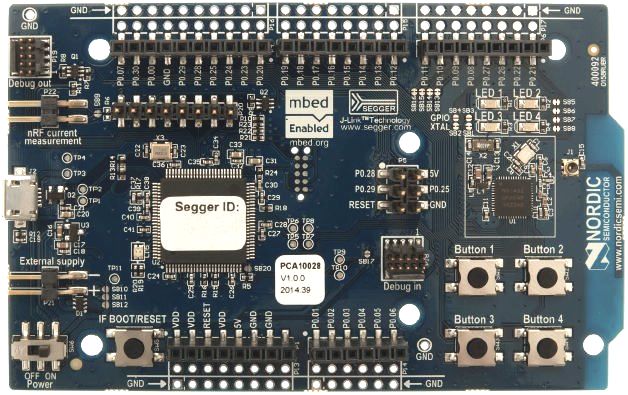This is a great platform for learning more about BLE and the ARM Cortex-M0 architecture.
It seems as if every company I’ve worked with in the past 6 months is using the Nordic nRF5x. The nRF51 is an “ultra-low power” SoC consisting of a Cortex-M0 MCU with an integrated 2.4GHz transceiver. Nordic also supplies software stacks supporting various BLE configurations as well as other useful features like DFU & OTA updates.
The Nordic chips are directly usable as the primary SoC in low-powered BLE devices. However, I also note a trend of using nRF5x SoCs as a secondary processor in complex systems. Since Nordic provides a fully functional BLE stack, a paired Nordic SoC can be used to handle BLE comms, freeing up the main system processor for other tasks. Other systems take advantage of the low power and use it as an always-on processor that monitors various inputs and wakes the primary system when required.
Due to their ubiquity, I recommend familiarizing yourself with this platform. Nordic provides an SDK for their nRF5x series of parts, which is geared toward their dev boards.
To support nRF51 development, Nordic provides the nRF51 DK. The kit supports development for the nRF51822, nRF51824, and nRF51422 SoCs. The kit is also compatible with Arduino shields, providing interesting prototyping options right out of the box. Nordic also highlights that the nRF51 DK can be used as a low-cost Bluetooth LE packet sniffer by using their nRF Sniffer software.
The nRF51 DK is also compatible with ARM mbed.
More on the nRF51 and nRF51 DK:


I find it incredibly annoying that the SDK does not exactly provide a guide to developing without the development kit.
I may update this thread when I get a leadway.
The problems I ran into were from configuring Segger Embedded Studio (SES). to work with SDK v12.3. SES does not have a project configuration file for that v12.3. I eventually resulted to modifying an example makefile, defining paths to local arm-gcc installation, and just calling make. Poof. Problem solved.